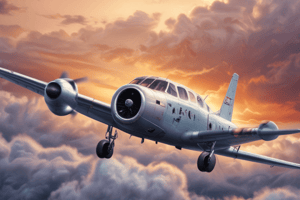Podcast
Questions and Answers
What is the structure of the atmosphere composed of?
What is the structure of the atmosphere composed of?
- 90% nitrogen, 10% oxygen
- 100% carbon dioxide
- 50% nitrogen, 50% oxygen
- 78% nitrogen, 21% oxygen, 1% other gases (correct)
What does atmospheric pressure refer to?
What does atmospheric pressure refer to?
The pressure caused by the weight of the atmosphere.
What is ISA?
What is ISA?
International Standard Atmosphere.
What is pressure altitude?
What is pressure altitude?
What is density altitude?
What is density altitude?
Density is directly proportional to pressure.
Density is directly proportional to pressure.
Density of air varies inversely with temperature at constant pressure.
Density of air varies inversely with temperature at constant pressure.
What effect does humidity have on air density?
What effect does humidity have on air density?
What is the formula for kinetic energy?
What is the formula for kinetic energy?
What is the formula for potential energy?
What is the formula for potential energy?
How is thrust defined?
How is thrust defined?
What distinguishes power from thrust?
What distinguishes power from thrust?
Positive climb performance occurs when an aircraft loses potential energy.
Positive climb performance occurs when an aircraft loses potential energy.
What is the angle of climb (AOC)?
What is the angle of climb (AOC)?
What is the rate of climb (ROC)?
What is the rate of climb (ROC)?
More weight the higher the ________
More weight the higher the ________
Flashcards
Atmospheric Pressure
Atmospheric Pressure
The force caused by the weight of the atmosphere pressing down on a surface.
Pressure Altitude
Pressure Altitude
The height above the standard datum plane (SDP) where atmospheric pressure is 29.92 inches of mercury (Hg).
Density Altitude
Density Altitude
Pressure altitude adjusted for nonstandard temperature.
International Standard Atmosphere (ISA)
International Standard Atmosphere (ISA)
Signup and view all the flashcards
Density
Density
Signup and view all the flashcards
Kinetic Energy
Kinetic Energy
Signup and view all the flashcards
Potential Energy
Potential Energy
Signup and view all the flashcards
Thrust
Thrust
Signup and view all the flashcards
Power
Power
Signup and view all the flashcards
Rate of Climb (ROC)
Rate of Climb (ROC)
Signup and view all the flashcards
Angle of Climb (AOC)
Angle of Climb (AOC)
Signup and view all the flashcards
Vy
Vy
Signup and view all the flashcards
Vx
Vx
Signup and view all the flashcards
Study Notes
Structure of Atmosphere
- Composed mainly of nitrogen (78%), oxygen (21%), and 1% other gases.
- Most oxygen is found below 35,000 feet altitude.
Atmospheric Pressure
- Caused by the weight of the atmosphere.
- Decreases with altitude, affecting power, thrust, and lift:
- Power reduction due to less air intake.
- Thrust reduction from propeller efficiency loss in thin air.
- Lift reduction as thin air exerts less force on airfoils.
- Standard pressure at sea level measures 29.92 inches of mercury (Hg).
- Pressure decreases approximately 1 Hg for every 1,000 feet gained in altitude, up to 10,000 feet.
International Standard Atmosphere (ISA)
- A standardized model used for aviation purposes.
Pressure Altitude
- Defined as height above the standard datum plane (SDP) where atmospheric pressure is 29.92 Hg.
- SDP can be at, below, or above sea level depending on atmospheric conditions.
Density Altitude
- Pressure altitude adjusted for nonstandard temperature.
- Higher density altitude signifies decreased aircraft performance, while lower density altitude signifies improved performance.
- Influenced by high elevations, low atmospheric pressure, high temperatures, and humidity.
Effects of Pressure on Density
- Density is directly proportional to pressure, assuming constant temperature.
- Doubling the pressure will double the density.
Effects of Temperature on Density
- Density inversely varies with temperature at constant pressure.
- Higher temperatures result in lower air density, while cooler temperatures increase density.
Effects of Humidity on Density
- Humidity reflects the level of water vapor in the air; warmer air holds more vapor.
- Moist air is lighter than dry air, decreasing overall density.
- Increasing humidity raises density altitude and reduces performance.
Kinetic Energy
- Defined by the formula KE = 1/2 x m x v².
- Represented by an aircraft's motion and velocity, with energy directly proportional to the square of speed.
Potential Energy
- Defined by the formula PE = m x g x h.
- Relates to an aircraft's position, specifically height.
Power vs Thrust
- Thrust is a force, measured in pounds or Newtons (N), exerted on an object.
- Power is the rate of work or energy transfer, typically measured in horsepower (hp) or kilowatts (kW).
- Power results from motion (KE and PE) created by thrust over time.
Positive Climb Performance
- Achieved by gaining potential energy (PE) through altitude increase.
- Aircraft climbs by converting airspeed (kinetic energy) into altitude (potential energy), exceeding power needed for level flight.
Angle of Climb (AOC)
- Represents altitude gain in relation to distance traveled.
- Maximum AOC performance occurs at Vx speed, ideal for short takeoffs with obstacle clearance.
- Achieved at a specific speed and angle of attack for maximum excess thrust.
Rate of Climb (ROC)
- Compares altitude gain to the time needed for that gain.
- Maximum ROC performance is reached at Vy speed, optimizing altitude gain over time.
Impact of Weight on Climbing
- Increased weight requires a higher angle of attack (AOA) for maintaining altitude and speed.
- Results in increased induced and parasitic drag, necessitating more thrust.
- Climb performance is further diminished at higher altitudes, as Vx and Vy adjust with environmental changes.
Studying That Suits You
Use AI to generate personalized quizzes and flashcards to suit your learning preferences.
Description
Explore the key concepts of aircraft performance in Chapter 11 of the PHAK. This chapter covers the structure of the atmosphere and how atmospheric pressure affects engine power, thrust, and lift. Test your understanding with these flashcards.



